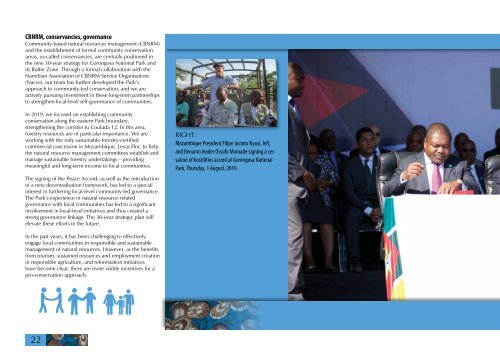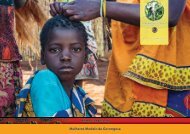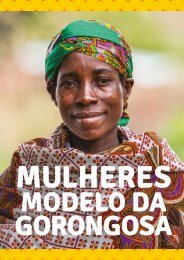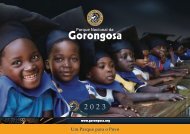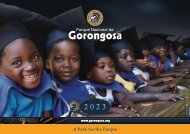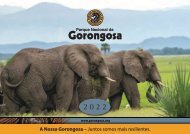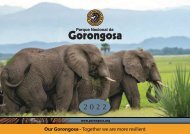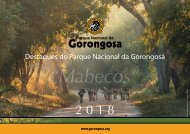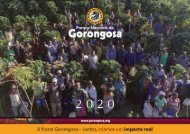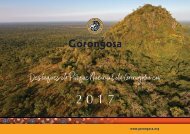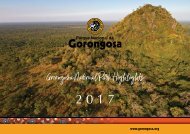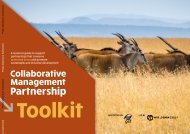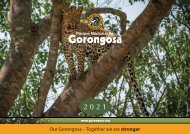2019 Highlights
You also want an ePaper? Increase the reach of your titles
YUMPU automatically turns print PDFs into web optimized ePapers that Google loves.
CBNRM, conservancies, governance<br />
Community-based natural resources management (CBNRM)<br />
and the establishment of formal community conservation<br />
areas, so-called conservancies, are centrally positioned in<br />
the new 30-year strategy for Gorongosa National Park and<br />
its Buffer Zone. Through a formal collaboration with the<br />
Namibian Association of CBNRM Service Organisations<br />
(Nacso), our team has further developed the Park’s<br />
approach to community-led conservation, and we are<br />
actively pursuing investment in these long-term partnerships<br />
to strengthen local-level self-governance of communities.<br />
In <strong>2019</strong>, we focused on establishing community<br />
conservation along the eastern Park boundary,<br />
strengthening the corridor to Coutada 12. In this area,<br />
forestry resources are of particular importance. We are<br />
working with the only sustainable-forestry-certified<br />
commercial concession in Mozambique, Levas Flor, to help<br />
the natural resource management committees establish and<br />
manage sustainable forestry undertakings – providing<br />
meaningful and long-term income to local communities.<br />
The signing of the Peace Accord, as well as the introduction<br />
of a new decentralisation framework, has led to a special<br />
interest in furthering local-level community-led governance.<br />
The Park’s experience in natural resource-related<br />
governance with local communities has led to a significant<br />
involvement in local-level initiatives and thus created a<br />
strong governance linkage. The 30-year strategic plan will<br />
elevate these efforts in the future.<br />
In the past years, it has been challenging to effectively<br />
engage local communities in responsible and sustainable<br />
management of natural resources. However, as the benefits<br />
from tourism, sustained resources and employment creation<br />
in responsible agriculture, and reforestation initiatives<br />
have become clear, there are more visible incentives for a<br />
pro-conservation approach.<br />
© Gorongosa Media<br />
RIGHT:<br />
Mozambique President Filipe Jacinto Nyusi, left,<br />
and Renamo leader Ossufo Momade signing a cessation<br />
of hostilities accord at Gorongosa National<br />
Park, Thursday, 1 August, <strong>2019</strong>.<br />
© Gorongosa Media<br />
Cyclone Idai demonstrated how important it is to manage natural resources well, and that land-use planning is vital. Settling<br />
in flood areas may be good for agriculture, but will be dangerous if flooding becomes more common. Our participatory<br />
approaches to working with communities and district government is aimed at improved planning to develop sound land-use<br />
strategies, including setting aside vulnerable areas for conservation.<br />
In 2018/19 we undertook community visioning processes with natural resource management committees in 16 local<br />
communities in the Buffer Zone and started the same process at the village level. These discussions allowed the<br />
communities to reflect on their behaviour and attitudes; how they relate to their future, and what the community can do<br />
to ensure a desirable future. We also involved community rangers and activators in the process to guide discussions about<br />
conservation education, and enforce local and state regulations on natural resources access, control and use.<br />
Agricultural Livelihoods Program: farming for biodiversity with inclusivity<br />
The Gorongosa Project’s Agricultural Livelihood Program has two core values: inclusive value chains and farming for<br />
biodiversity. Inclusivity, in practice, centers around working with women for business and employment creation,<br />
empowerment, gender training and solutions, financial inclusion, and access. It also encompasses capturing traditional<br />
knowledge through free and informed consent, intergenerational learning, and preservation and use of indigenous<br />
knowledge. The project is community driven and coordinates its efforts through working closely with community leaders<br />
and organizations in natural resources management, education and health. Biodiversity is conserved by key principles of<br />
land management, agroforestry, and promoting ambassador species that are symbolic for issues or ecosystems to build<br />
awareness and behavior change.<br />
As a result, the project has proved resilient against the periodic onset of regional instability and extreme climatic events,<br />
including the recent devastation by Cyclone Idai, which severely affected infrastructure. Gorongosa Coffee also offers small<br />
producers the option for expansion over time, focusing on developing emerging farmers through an array of agroforestry<br />
alternatives such as honey production, inter-row cropping options and seasonal employment. This critical flexibility has<br />
provided the impetus for communities to adopt conservation principles and take ownership of the project.<br />
‘Gorongosa ... is no longer a centre of violence between brothers and against<br />
the flora and fauna that exists here.’<br />
Filipe Jacinto Nyusi, President of the Republic of Mozambique<br />
22 23


